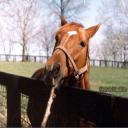Yahoo Answers is shutting down on May 4th, 2021 (Eastern Time) and beginning April 20th, 2021 (Eastern Time) the Yahoo Answers website will be in read-only mode. There will be no changes to other Yahoo properties or services, or your Yahoo account. You can find more information about the Yahoo Answers shutdown and how to download your data on this help page.
Trending News
Why do they let 20 horses race in the Kentucky Derby?
I know it's great to give the long shots a chance, but it seems dangerous for the horses and jockeys.
6 Answers
- LauraRossLv 69 years agoFavorite Answer
In the US, 20 is a large number of horses to race, but it isn't uncommon in other countries. One can see fields of 15 horses in turf races in the US, so the jockeys that ride have plenty of experience. Jocks are concerned with their own mount and those directly in front, to the side and behind them. They don't worry too much about the horses that are several lengths in front or behind.
Horses are instinctively pack animals, so they are comfortable in large fields. Unless a horse is green (immature) and blows the turn or isn't capable of running in a straight line, there normally isn't a problem. Yes, there's the average bumping and a hole may close on a jock, but that's typical in any race. I've seen five horse fields look like bumper car competition.
Falls, etc. are pretty uncommon in the Derby. Sometimes a horse breaks down, but the jocks are well versed in staying out of trouble and will let those around them know the situation to avoid further accidents.
Source(s): Pedigree Analyst/handicapper - malanLv 44 years ago
nicely the Derby is a million.25miles and the prevailing time is often approximately 2 minutes. switched over to mph is approximately 37-37.5mph. Edit:be conscious that's average velocity over the 2minutes. Acceleration probaby components some version of this parent. The quickest horses (quarterhorses) i know can run on the brink of 50mph over short distances.
- JSCLv 69 years ago
It's the Derby, it's always been like that, even more horses before the change. It's like any other sport where mishaps can and do occur !! I see you have some Great Fact Based Answers no need to add more here...thumbs up on question too..looks like the thumbs down troll was here again..lol..we all know who she is..!
- FarOutsideLv 79 years ago
They used to "allow" any number of horses compete. If you thought your horse was good enough, and had the thousands to spend on entry, you could race.
However, Churchill Downs started receiving too many entries of unqualifed horses and decided to limit the entries to twenty. The entrants with the twenty highest purse earnings get to race.
- How do you think about the answers? You can sign in to vote the answer.
- Sandra S.Lv 79 years ago
I like to make clear is what is most overlooked, and that it costs a decent amount of money to run in this most historic race in the country. It costs $50,000 just to break out of the starting gate, meaning most people are dropping a pretty penny to run in a race they are statistically unlikely to win. The Kentucky Derby race holds a unique place in the public's imagination that is unlikely to be topped. Beyond the public at large, the Kentucky Derby remains the ultimate goal and dream for most owners, trainers and breeders. So, if you look at it from that standpoint, the full field is pretty understandable.
YES, for sure a 20 Horse Field 'is' dangerous for horses and Jockey's..making this a very good question, however, it isn't an easy question to answer, since there are many opinions that surround this. And, one thing I do know, any tragedy in this industry, leads to change (for the better). I've lifted information straight from the horses mouth Churchill Downs regarding Kentucky Derby Safety-
The field size for the Kentucky Derby will remain unchanged at a maximum of 20 horses, a limit that was put in place after 23 horses competed in the 1974 Kentucky Derby and 21 horses competed in 1981. “We are focused on action that we know will make a difference,” Evans said. “Our priority remains on the enhancement and standardization of practices that will have a daily impact on the health and safety of the maximum number of horses and jockeys that compete at Churchill Downs Incorporated tracks.”
“As in all sports, there’s an inherent safety risk involved in horse racing,” said Jim Gates, general manager of Churchill Downs racetrack and the leader of the “Safety from Start to Finish” initiative. “We firmly believe that the measures and policies we’ve put in place will help to minimize that risk and better ensure the safety and well-being of our athletes. We’re passionate about this commitment, and we’ll continue, as an industry leader, to do what’s right to reduce injuries and improve the integrity of the sport.”
The safety initiatives announced as part of “Safety from Start to Finish” will continue to evolve. “There are a number of other important safety initiatives that are still in development, and that we hope to launch later this year,” Gates said. Those include:
* Out-of competition drug testing;
* The introduction of safety reins;
* Jockey health and wellness programs;
* Uniform licensing of those involved in racing; and
* Ongoing safety and welfare education and training of those involved in racing.
“We also have recognized that we need to do a better job of communicating to our fans and the general public what our industry has done and is doing to maximize safety,” Gates added. “To that end, we have created an interactive, educational ‘Safety Center’ that is currently on display at Churchill Downs’ Gate 17. The Center utilizes audio, video and actual material and equipment samples to educate racetrack guests about the numerous policies and procedures in place to ensure the safety, security and well-being of horses, riders, and on-track personnel. The Centers may be added at other CDI racetracks at a future date.”
The cost of the safety measures has not been finalized, but is expected to exceed $1 million annually – a figure that is in addition to the millions already spent annually on safety at CDI tracks.
For more information about the Churchill Downs “Safety from Start to Finish” initiative, please visit the Safety Center at Gate 17 at Churchill Downs racetrack, or visit http://www.churchilldowns.com/safety
:)
- Anonymous9 years ago
money for the track, plain and simple.







